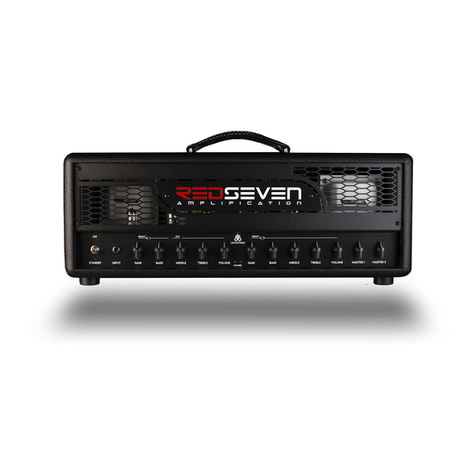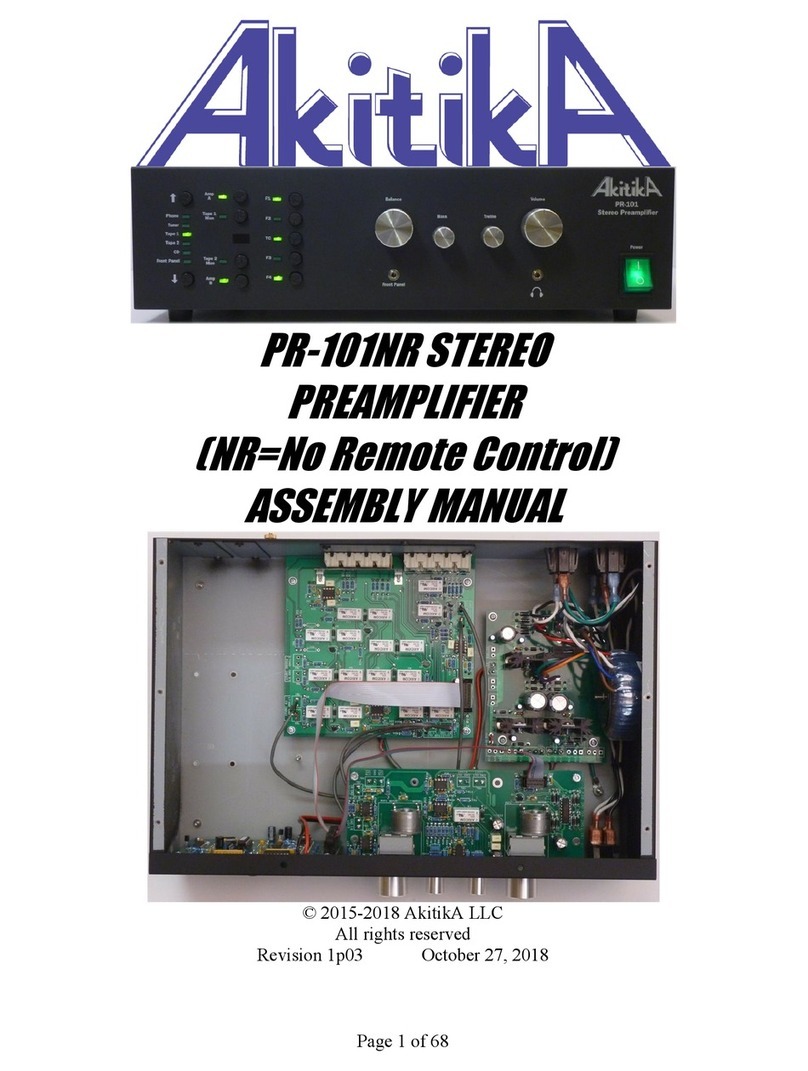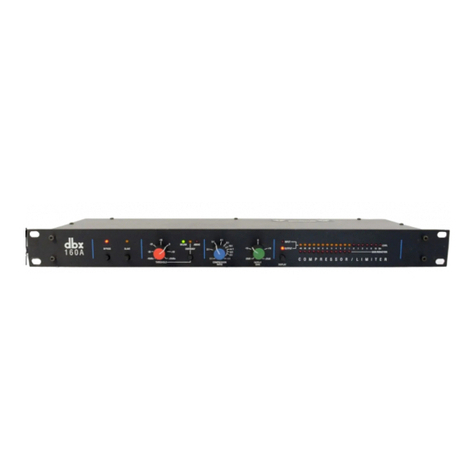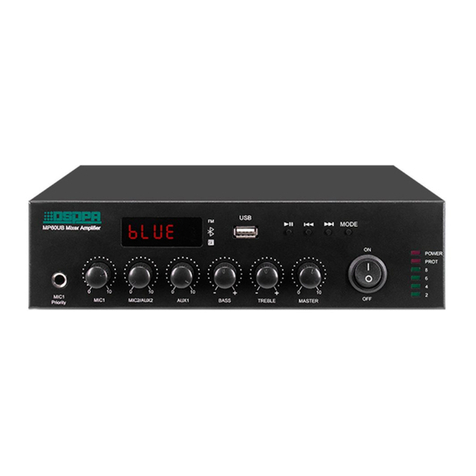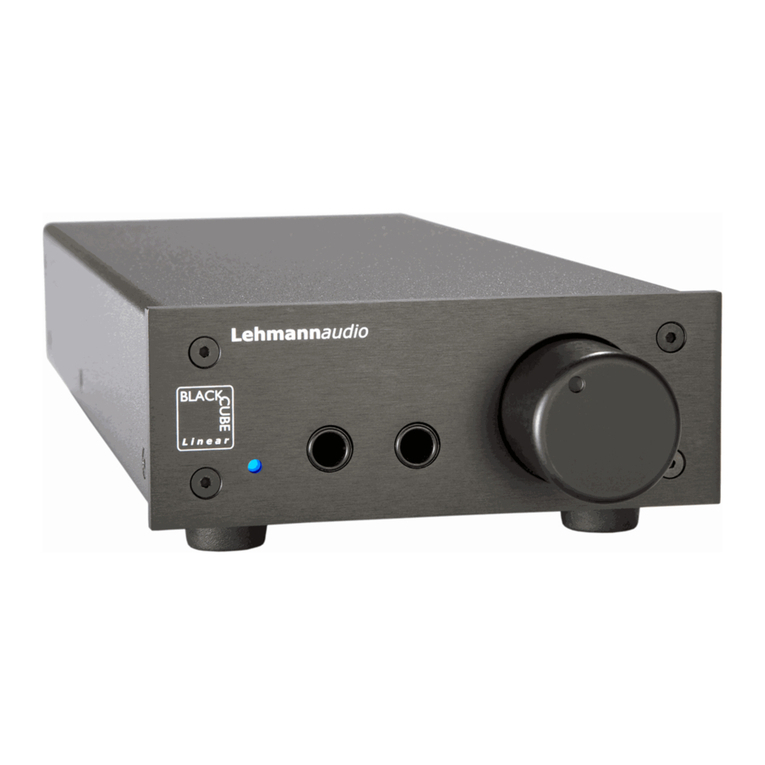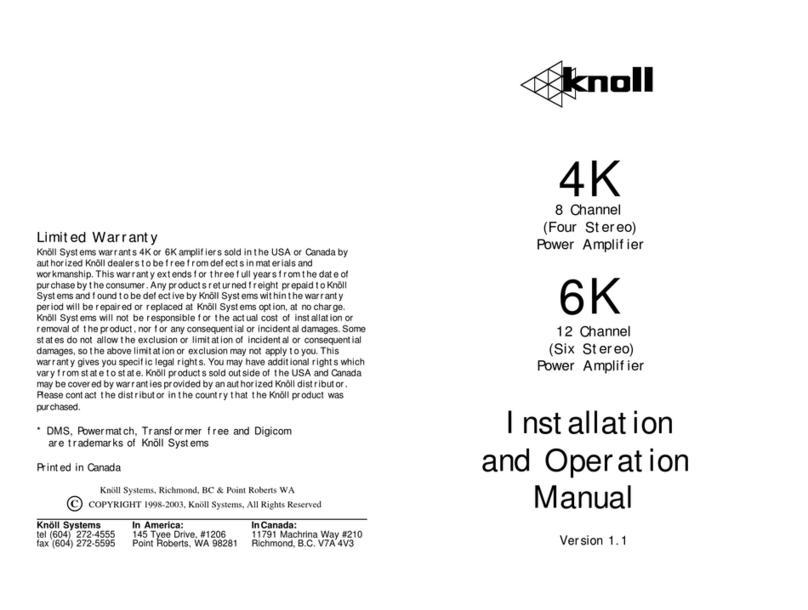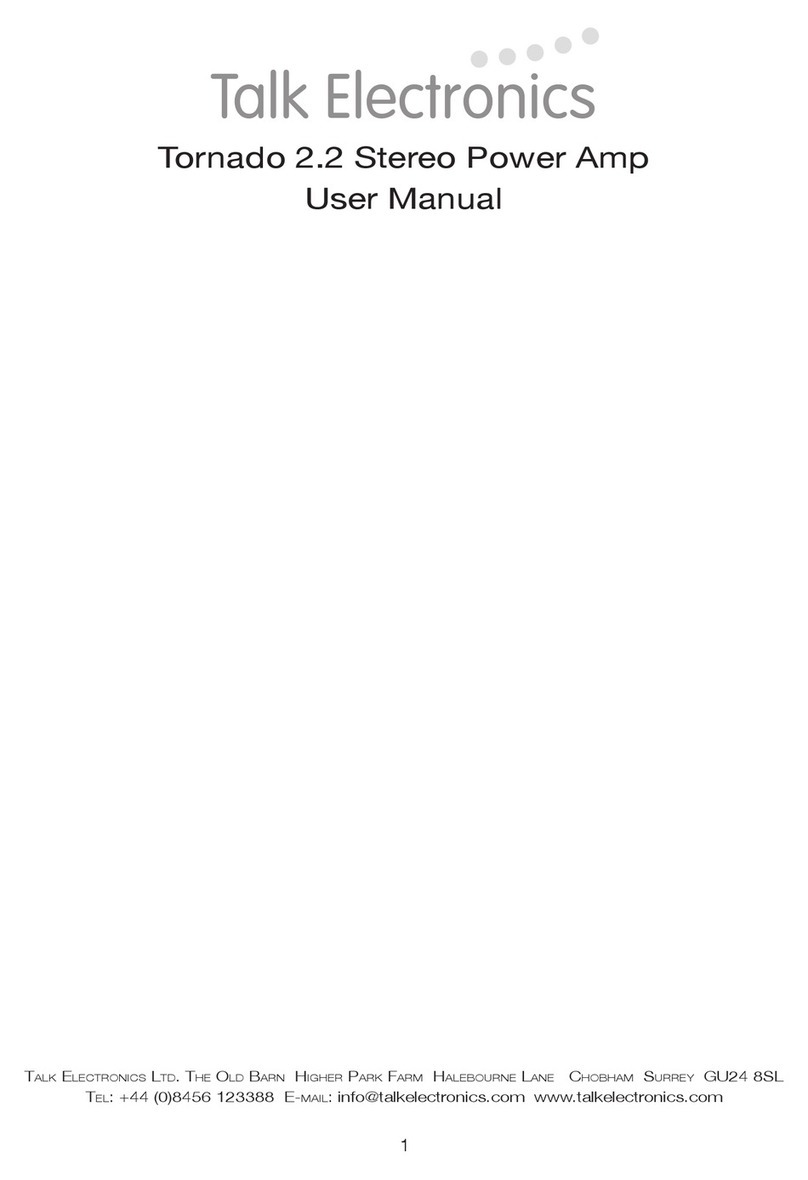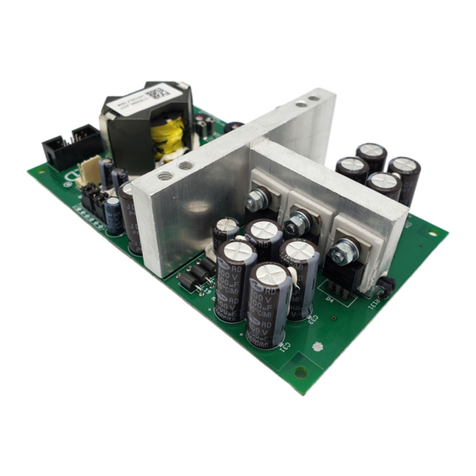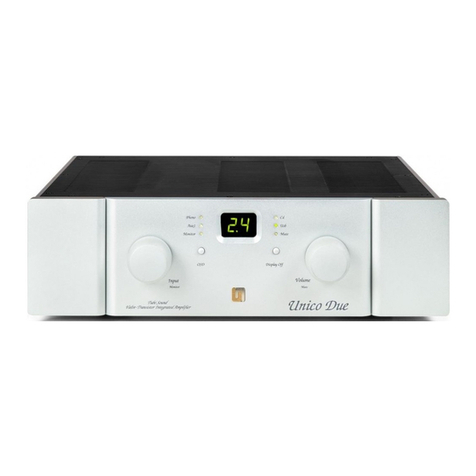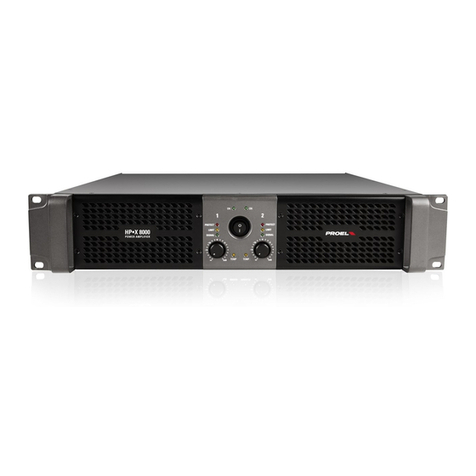LINN LINTO PACK 147 User manual

DIRECT COUPLED PRECISION PHONO PREAMPLIFIER
OWNERS MANUAL
LINN LINTO
§cover 28/11/97, 4:37 pm3

i
Important safety information
Explanation of symbols used in this manual and on the product:
This symbol is intended to alert the user to the presence of
uninsulated dangerous voltages within the enclosure of sufficient
magnitude to cause electric shock.
This symbol is intended to alert the user to the presence of
important maintenance and servicing information in the instruction
and service manuals.
CAUTION
TO REDUCE THE RISK OF ELECTRIC SHOCK DO NOT REMOVE THE
COVER.
NO USER SERVICEABLE PARTS INSIDE.
REFER SERVICING TO QUALIFIED SERVICE PERSONNEL.
WARNING: SHOCK HAZARD. DO NOT OPEN.
AVIS: RISQUE DE CHOC ELECTRIQUE. NE PAS OUVRIR.
CAUTION: REPLACE FUSE WITH SAME TYPE AND RATING.
ATTENTION: UTILISER UN FUSIBLE DE RECHANGE DE MÊME TYPE.
DISCONNECT SUPPLY CORD BEFORE CHANGING FUSE.
ATTENTION: DEBRANCHER AVANT DE REMPLACER LE FUSIBLE.
WARNING
TO REDUCE THE RISK OF ELECTRIC SHOCK DO NOT EXPOSE THIS
APPLIANCE TO RAIN OR MOISTURE.
MAINS PLUGS
This appliance is supplied with a non-rewireable mains plug for the
intended country.
Replacement mains leads can be obtained from your Linn retailer.
Should you need to change the plug please dispose of it carefully.
A plug with bared conductors is dangerous if engaged in a live socket.
The Brown wire must be connected to the Live (Line) supply pin.
The Blue wire must be connected to the Neutral supply pin.
The Green/Yellow wire must be connected to the Earth (Ground) supply
pin.
Please contact your retailer or a competent electrician if you are in any
doubt.
§0 Preface 28/11/97, 4:37 pm1

ii
GENERAL SAFETY INSTRUCTIONS
1. Read instructions. Read the safety and operating instructions before
operating the appliance.
2. Retain instructions. Retain the safety and operating instructions for future
reference.
3. Heed warnings. Observe all warnings on the appliance and in the operating
instructions.
4. Follow instructions. Follow all operating and use instructions.
5. Water and moisture. Do not use the appliance near water, for example near
a bathtub, washbowl, kitchen sink, laundry tub, in a wet basement, or near
a swimming pool and the like.
6. Carts and stands. Use only with a cart or stand that is recommended by the
manufacturer.
6a. An appliance and cart combination should be used with care. Quick stops,
excessive force, and uneven surfaces may cause the appliance and cart
combination to overturn.
7. Wall or ceiling mounting. Mount to a wall or ceiling only as recommended
by the manufacturer.
8. Ventilation. Site the appliance so that its location or position does not
interfere with its proper ventilation. For example, the appliance should not
be situated on a bed, sofa, rug, or similar surface that may block the
ventilation openings, or placed in a built-in installation such as a bookcase
or cabinet that may impede the flow of air through the ventilation
openings.
9. Heat. Site the appliance away from heat sources such as radiators, heaters,
stoves, or other appliances (including amplifiers) that produce heat.
10. Power sources. Connect the appliance to a power supply only of the type
described in the operating instructions or marked on the appliance.
11. Grounding or polarisation. Do not defeat the precautions taken to ground
or polarise the supply to the appliance.
12. Power cord protection. Route power cords so that they are not likely to be
walked on or pinched by items placed upon or against them, paying
particular attention to cords at plugs, power sockets, and at the point
where they exit from the appliance.
13. Protective attachment plug. As a safety feature the product is equipped
with an attachment plug containing overload protection. See the
instruction manual about resetting or replacing the plug. Should the plug
need replacing ensure that a replacement is used which has the same
overload protection as the original.
14. Cleaning. The product should be cleaned only as recommended by the
manufacturer.
15. Power lines. An outdoor antenna should be located away from power lines.
16. Outdoor antenna grounding. If an outdoor antenna is connected to the
tuner/receiver ensure that the antenna system is grounded to provide
some protection against voltage surges and static build up.
In the USA see article 810 of the National Electrical Code ANSI/NFPA 70
concerning installation requirements.
17. Non-use periods. Unplug the power cord from the outlet if the product will
be unused for a long period of time.
§0 Preface 28/11/97, 4:37 pm2

iii
18. Objects and liquid entry. Take care not to let objects or liquids fall into the
product.
19. Damage requiring service. The product should be serviced by qualified
personnel if:
a) The power cord or plug has been damaged.
b) Objects or liquid have fallen into the product.
c) The product has been exposed to rain.
d) The product does not appear to operate normally or exhibits a marked
change in operation.
e) The product has been dropped or the enclosure damaged.
20. Servicing. Don’t attempt to service the product beyond that described in
the operating instructions. All other servicing should be referred to qualified
service personnel.
UK USERS PLEASE READ THIS IMPORTANT SAFETY INFORMATION
Fuse replacement
This appliance is fitted with a non-rewireable 13 Amp mains plug. The plug
contains a 5 Amp fuse. If the fuse has blown it can be replaced as follows:
a) Pull out the red fuse cover/carrier.
b) Remove and dispose of the blown fuse.
c) Fit a new 5 Amp BS1362 approved fuse into the carrier and push the
carrier back into the plug.
Always ensure the fuse cover is fitted. If the fuse cover is missing do not use
the plug. Contact your Linn retailer to obtain a replacement fuse cover.
Fuses are for fire protection and do not protect against electric shock.
Mains plug replacement
Should your mains plug need replacing and you are competent to do this
proceed as follows. If you are in doubt contact your Linn retailer or a
competent electrician.
a) Disconnect the plug from the mains supply.
b) Cut off the plug and dispose of it safely. A plug with bared conductors is
dangerous if engaged in a live socket.
c) Only fit a 13 Amp BS1363A approved plug with a 5 Amp fuse.
d) The cable wire colours or a letter will be marked at the connection points
of most quality plugs.
Attach the wires securely to their respective points. The Brown wire must
go to the Live pin, the Blue wire must go to the Neutral pin, and the
Green/Yellow wire must go to the Earth pin.
e) Before replacing the plug top ensure that the cable restraint is holding
the outer sheath of the cable firmly and that the wires are correctly
connected.
WARNING
THIS APPLIANCE MUST BE EARTHED.
§0 Preface 28/11/97, 4:37 pm3

iv
Copyright and acknowledgements
Copyright © Linn Products Limited.
Linn Products Limited, Floors Road, Waterfoot, Glasgow, G76 0EP,
Scotland, United Kingdom.
All rights reserved. No part of this publication may be reproduced,
stored in a retrieval system, or transmitted, in any form or by any
means, electronic, mechanical, photocopying, recording, or
otherwise, without the prior written permission of the publisher.
Printed in the United Kingdom.
Linto is a trademark of Linn Products Limited.
The information in this manual is furnished for informational use
only, is subject to change without notice, and should not be
construed as a commitment by Linn Products Limited. Linn
Products Limited assumes no responsibility or liability for any errors
or inaccuracies that may appear in this manual.
Part no: PACK 147
This manual was produced by Human-Computer Interface Ltd,
Cambridge, England.
§0 Preface 28/11/97, 4:37 pm4

v
Contents
Introduction ........................................ 1
The Linto and music ........................................ 2
Some background information ........................................ 2
Setting up the Linto ........................................ 6
Unpacking ........................................ 6
Positioning ........................................ 8
Connecting ........................................ 8
Guarantee and service ........................................ 10
Technical information ........................................ 11
Specifications ........................................ 11
Index ........................................ 13
§0 Preface 28/11/97, 4:37 pm5

vi
§0 Preface 28/11/97, 4:37 pm6

1
Introduction
We believe that good music is not a luxury, but a necessity, and we
at Linn have dedicated the better part of two decades to making
sure that our customers are given the best possible experience of
the music they love. In other words, we take music seriously, which
is why we dedicate ourselves to building hi-fi which sets the highest
possible standards in bringing music to life within your home.
Listening to a Linn hi-fi system should be the nearest you can get to
being at a superb live performance. By using the Linn Linto in
conjunction with your Linn system, you bring that live performance
to your home. Once up and running, the Linto will bring you an
unrivalled listening experience from your record collection that we
know you’ll enjoy again and again.
To do that, you need to know exactly how to get the best out of
your Linto and that is what this manual is all about. In the next few
pages you will find out everything you need to know about how to
set up the Linto, and how to use it to get the best possible results.
We hope that you will spend a few minutes getting to know the
Linto well, and so derive the maximum enjoyment from it.
Listening to your new
Linn hi-fi should be the
nearest you can get to
being at a superb live
performance.
LinnLINTO
§1 Intro 28/11/97, 4:38 pm1

2
LINN LINTO
The Linto and music
The Linn Linto direct coupled precision phono preamplifier is
the culmination of fourteen years of development and
manufacturing of ultra low noise audio circuitry.
Linn’s interest in phono preamplifiers started
when we developed our own record mastering
system in 1983. As we improved our mastering
lathe we reached the point where we could no
longer measure the noise from it on the master
discs. The measurement was limited by the residual
noise from the phono preamplifier in our measurement
system.
We therefore invested many months of research into developing a
very quiet phono preamplifier to allow us to continue the
development and improvement of our mastering system. This
design was further developed and eventually used in our first audio
preamplifier. The Linto is our third generation phono preamplifier,
taking advantage of all the experience gained by making records,
record players and electronics.
Some background information
The scale of the signals involved in a moving coil preamplifier make
the design an interesting challenge. Linn MC cartridges generate
about 100µV (100 millionths of a Volt) from a reference ‘cut
velocity’ on a record. This represents a fairly loud signal. A modest
background noise level from a phono preamplifier would be about
100nV (100 thousand-millionths of a Volt). A low noise level would
be closer to 10nV.
§1 Intro 28/11/97, 4:38 pm2

3
One of the delights of a good audio system is that it allows you to
hear signals which are below the ‘noise floor’. This understanding,
and how to achieve it, has transformed the performance of digital
audio systems since the first (very rough!) digital recordings.
It is however naïve to assume that just because a signal is in the
analogue domain you get this resolution ‘for free’. A moving coil
preamplifier is probably the best example of this.
The conventional method of making a stable amplifier is to have an
amplifier with much more gain (amplification) than required, and
then to ‘feed back’ some of the output signal to the input such as
to reduce the input signal to the amplifier and reduce its gain to
the required amount. This gives a very predictable, stable amplifier
with (generally) a high input impedance (so it does not load the
signal source), a low output impedance (so it can drive the next
stage), a very controlled gain and low distortion. For most signals
this is a completely acceptable arrangement.
However when the original signal is of the levels mentioned above
a problem appears. A reasonable feedback amplifier would feed
back about 99.9% of the input signal. This has the effect of
reducing the
true
input (what the amplifying devices see) to about
one thousandth of the signal from the source. In the case of a MC
signal we end up with a
true
input of a few pV (million-millionths of
a Volt). This is now a very small signal. In fact it is so small that in
the transient times of a music signal not many electrons get to
move through the amplifying devices. The result is that the
amplifier stops amplifying very small signals and information is lost.
The circuitry of the Linto was designed to get around this
fundamental limitation and to extract all available information from
a moving coil cartridge. The input stage actually takes signal power
§1 Intro 28/11/97, 4:38 pm3

4
from the cartridge (about 25pW) and transfers this directly into the
amplifying transistors. In most other preamplifiers this power is
wasted in resistors and cartridge loading networks. This signal
power transfer sets the ultimate resolution of the Linto well above
conventional preamplifiers. Every available electron is used!
Loading networks
Unlike other MC preamps the Linto does not have an adjustable
loading network. A moving coil cartridge has a very low output
impedance (a few Ohms) and is relatively unaffected by any
reasonable loading impedance. A loading network does two
things: it wastes valuable signal power, and it generates more
signal and noise than the cartridge.
A cartridge loading network is usually altered by switching in
resistors and capacitors. The switch contacts alone can generate
more voltage than the cartridge!
A cartridge loading network also increases the size of the circuitry
on the input of the amplifier. We have gone to extreme lengths to
keep the connection from the input sockets to the amplifier
transistors as short as possible and enclosing the minimum possible
area. Our precision surface mount technology makes this possible.
A square centimetre of circuit area can pick up more interference
signal than the cartridge generates as music signal.
The Linto makes one concession to flexibility. To accommodate the
highest output moving coil cartridges which could overdrive the
Linto or a subsequent control amplifier there is a single wire link
which can be cut to drop the gain by 10dB. We recommend that
you only use this if the front panel indicator light flashes red while
playing a loud record.
§1 Intro 28/11/97, 4:38 pm4

5
RF immunity
Radio Frequency Interference is the bane of phono inputs.
Obviously with the signal levels involved a MC preamplifier is likely
to pick up radio signals. The Linto was designed from the outset to
have high immunity to RF interference. Instead of relying purely on
filtering and screening the circuitry itself is ‘well behaved’ at radio
frequencies. The fixed input loading network forms an RF filter,
doing nothing in the audio band.
Power supply technology
The Linto is unique in many ways but especially in its use of the
Linn Brilliant switch mode power supply. This technology, with
which we now have several years experience, goes completely
against conventional audio practice which for many years has used
ever larger transformers and capacitors for audio equipment power
supplies. Current conventional thinking would use a power supply
capable of delivering several hundred Watts to power a
preamplifier requiring under five Watts. Obviously something is not
quite right here!
The Brilliant slimline power supply is our solution to the problem. It
converts the incoming mains into a very high voltage DC then
chops it up at a high frequency before applying it to a transformer
measuring about 30mm square. The output of this tiny transformer
is then converted back to a very smooth DC voltage. To make this
technique work as an audio power supply, and understand why it
works, took two years of hard work and involved expensive
research.
§1 Intro 28/11/97, 4:38 pm5

6
Setting up the Linto
This chapter explains how to unpack your Linn Linto direct coupled
precision phono preamplifier, and how to install it with your other
hi-fi components.
Unpacking
Before connecting the Linto to the mains supply, you should check
the following:
• that everything is in the box
• that the correct voltage has been selected
• that the correct fuse has been fitted.
What is in the box
The Linto comes in a box with the following accessories:
• a mains lead
• one phono to phono lead
• two 800mA fuses
• this manual.
We recommend you retain the packaging in case you need to
transport the Linto at a later date.
Fuse ratings
120V and 240V settings: T800mA
§2 Setting up 28/11/97, 4:38 pm6

7
Replacing the fuse
Should the mains fuse blow replace it only with an equivalent part.
The fuse holder is located just below the mains inlet socket. To
replace the fuse disconnect the product from the mains supply.
Using a flat blade screwdriver remove and replace the fuse. If the
fuse blows a second time there is a fault in the product. Contact
your local retailer.
Mains voltage operating range
120V setting: 90Vac to 132Vac. 50Hz to 400Hz.
240V setting: 180Vac to 264Vac. 50Hz to 400Hz.
Setting the mains operating voltage
All products with a voltage selector switch must be set to the local
mains supply voltage before connecting to the mains supply.
Please check the setting of the voltage selector switch at the mains
input socket before connecting the product to a mains supply.
To set the mains operating voltage unplug the mains supply cable
and using a flat blade screwdriver turn the selector switch to the
appropriate voltage.
WARNING!! THE POWER SUPPLY MAY BE DESTROYED IF IT IS
CONNECTED TO 240V WHEN SET FOR 120V.
Earthing the Linto
The earthed moulded mains lead supplied must always be used
with the Linto. Never use an unearthed plug or adaptor.
§2 Setting up 28/11/97, 4:38 pm7

8
Positioning
The Linto needs to be close to the turntable (and cartridge). It
needs to be kept away from mains transformers in other
equipment. Power amplifiers need to be kept at least 30cm away.
When properly installed there will be no audible hum, only a very
gentle hiss at full volume.
Connecting
The following diagram shows the connections for the rear panel of
the Linto:
R
L
R
L
INPUT OUTPUT
120
240
EARTH
CONNECTION
AUDIO
INPUTS
AUDIO
OUTPUTS
VOLTAGE
SELECTOR
FUSE
MAINS INPUT
Connections
The connections are very simple. There are two sets of identical
outputs from the Linto allowing feeds to both a control amplifier
and, for example, a multi room sound distribution system.
§2 Setting up 28/11/97, 5:00 pm8

9
Operation
The power consumption of the Linto is very low. Nothing in it runs
hot so it can be left on continuously with no wear or tear.
Alternatively just switch it on when you play records (which will be
all the time…). It doesn’t need much warm up time. The output is
well de-thumped so even if you do not turn down the volume
control on your control amplifier you won’t get a fright when you
switch the Linto on and off.
The front panel light is normally green. There is an overload detector
in the Linto which will change the light to red if an overload occurs.
This will only happen with very high output cartridges, in which case
get your retailer to cut the gain reduction links.
§2 Setting up 28/11/97, 4:38 pm9

10
Guarantee and service
This product is guaranteed under the conditions which apply in the
country of purchase.
In addition to any statutory rights the customer may have, we
undertake to replace any parts which have failed due to faulty
manufacture. To help us, please ask your Linn retailer about the
Linn warranty scheme in operation in your country.
In the UK and other markets an extended warranty is offered,
where this scheme is in operation, to customers who register their
purchase with Linn. A registration card can be obtained from your
Linn retailer and should be stamped by them. This will also enable
you to receive the Linn RECORD newsletter and details of hi-fi and
music available from Linn.
Warning
Refer all enquiries to authorised Linn retailers only. Unauthorised
servicing or dismantling of the product invalidates the
manufacturer’s warranty.
If you are in any doubt, please contact your nearest Linn retailer.
For information on your nearest Linn retailer, contact the Linn
factory in Scotland or your national distributor.
Important
1 Please keep a copy of the sales receipt to establish the purchase
date of the product.
2 Please ensure that your equipment is insured by you during any
transit or shipment for repair.
§3 Guarantee 28/11/97, 4:39 pm10

11
Technical information
Specifications
Input connectors One pair of gold plated, direct circuit board
mounting RCA phono.
Output connectors Two pairs of gold plated, direct circuit board
mounting RCA phono.
Audio input level 150µV nominal on high gain setting.
500µV nominal on low gain setting.
Input impedance 150Ωin parallel with 4.7nF.
Output impedance 100Ω, both pairs of outputs.
Gain 64dB at 1KHz on high gain setting.
54dB at 1KHz on low gain setting.
Maximum input 6.7mV at 1KHz on high gain setting.
19mV at 1KHz on low gain setting.
Maximum output 10.1V p/p at 1KHz.
Mains supply 90Vac to 135Vac 50/60Hz or 190Vac to 264Vac,
50/60Hz, switched.
Power consumption 6 Watts, 12VA approximately.
Dimensions 320 x 320 x 80mm
Weight 1.5kg
Fuse rating 120V T800mA.
240V T800mA.
Safety approvals EN60065 (Europe), UL1270 (USA),
CSA22.2 (Canada).
EMC approval to European standards.
§4 Specification 28/11/97, 4:39 pm11

12
§4 Specification 28/11/97, 4:39 pm12

13
A
accessories 6
acknowledgements iv
audio input level 11
audio inputs 8
audio outputs 8
B
background information 2
C
cartridge loading networks 4
connections 8
copyright iv
cut velocity 2
F
feedback amplifiers 3
fuse 8
ratings 6
replacing iii, 7
G
guarantee 10
I
input impedance 11
introduction 1
Index
L
Linn Brilliant 5
Linto and music 2
loading networks 4
M
mains plugs i
mains voltage operating
range 7
N
noise floor 3
O
operation 9
overload detector 9
P
positioning 8
power consumption 9, 11
power supply technology 5
R
Radio Frequency
Interference 5
replacing the fuse iii
RF immunity 5
§5 Index 28/11/97, 4:39 pm13
Table of contents
